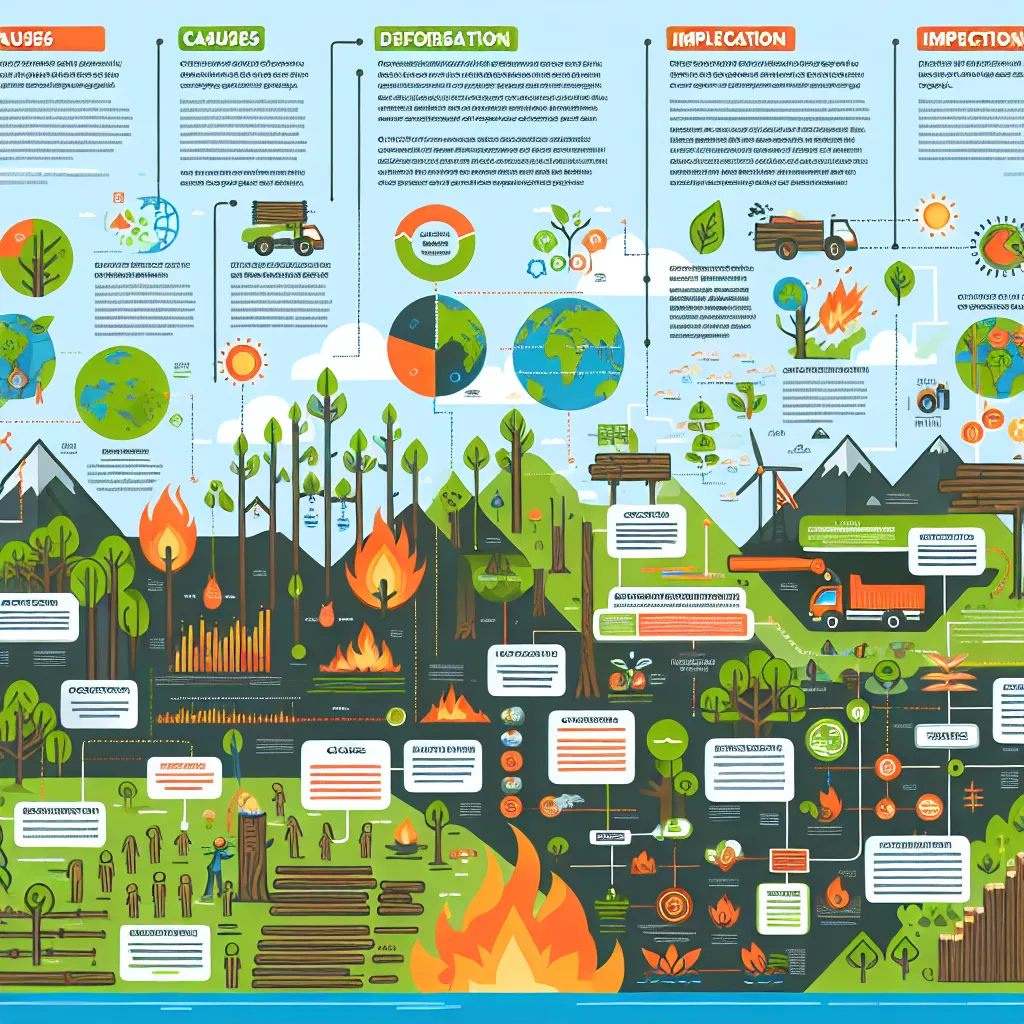Deforestation is a critical environmental issue that frequently appears in IELTS Writing Task 2 questions. Based on past exam trends and the growing global concern about environmental degradation, it’s highly likely that this topic will continue to be featured in future tests. Let’s explore a sample question and provide model essays to help you prepare effectively for this important subject.
Nội dung bài viết
 Deforestation challenges infographic
Deforestation challenges infographic
Analyzing the Question
Let’s examine a typical IELTS Writing Task 2 question on deforestation:
Deforestation is a major problem in many parts of the world. What are the main causes of this issue and what measures can governments and individuals take to tackle it?
This question is a classic example of a problem-solution essay. It requires you to:
- Identify the main causes of deforestation
- Suggest measures that both governments and individuals can take to address the problem
Remember to address all parts of the question in your response to achieve a high band score.
Sample Essay 1 (Band 8-9)
Deforestation has emerged as one of the most pressing environmental challenges of our time, with far-reaching consequences for biodiversity, climate stability, and human livelihoods. This essay will explore the primary drivers of this issue and propose a range of interventions that can be implemented by both governments and individuals to mitigate its impact.
The main causes of deforestation are multifaceted and often interconnected. Firstly, the expansion of agricultural land is a significant contributor, as forests are cleared to make way for crops and livestock grazing. Secondly, commercial logging, both legal and illegal, continues to deplete forest resources at an alarming rate. Thirdly, urbanization and infrastructure development often necessitate the clearing of wooded areas. Additionally, the demand for wood and paper products fuels ongoing deforestation in many regions.
To address these challenges, governments must play a crucial role. They can implement and enforce stricter regulations on logging and land-use change, while also providing incentives for sustainable forestry practices. Investing in reforestation programs and creating protected areas can help preserve existing forests and restore degraded lands. Furthermore, governments should promote alternative livelihoods for communities dependent on forest resources, such as ecotourism or sustainable agriculture.
Individuals also have a part to play in combating deforestation. Consumers can make conscious choices to support products made from sustainably sourced materials and reduce their consumption of single-use paper products. Participating in local tree-planting initiatives and supporting conservation organizations can contribute to reforestation efforts. Moreover, raising awareness about the importance of forests through education and social media can help build a collective commitment to forest preservation.
In conclusion, while deforestation poses a significant threat to our planet’s ecosystems, there are numerous avenues for both governmental action and individual involvement to address this issue. By combining policy measures, economic incentives, and personal responsibility, we can work towards a future where forests are valued, protected, and sustainably managed for the benefit of all.
(Word count: 309)
Sample Essay 2 (Band 6-7)
Deforestation is a big problem in many countries today. This essay will discuss the main reasons for this issue and suggest some ways that governments and people can help solve it.
One of the main causes of deforestation is farming. Many forests are cut down to make space for growing crops or raising animals. Another important reason is logging, where trees are cut down to sell wood. Also, as cities grow bigger, forests are often destroyed to build houses and roads.
Governments can do several things to help stop deforestation. They can make stricter laws to protect forests and punish people who cut down trees illegally. They can also give money to farmers to help them use better farming methods that don’t need as much land. Another good idea is to plant more trees in areas where forests have been cut down.
Individuals can also help in many ways. People can choose to buy products that are made without harming forests, like paper from recycled materials. They can also join local groups that plant trees in their communities. It’s important for everyone to learn about why forests are important and share this information with others.
In conclusion, deforestation is caused by farming, logging, and city growth. Both governments and individuals have important roles in solving this problem. By working together and making smart choices, we can help protect our forests for the future.
(Word count: 218)
Key Points to Remember When Writing
-
Address all parts of the question: Ensure you discuss both causes and solutions, including measures for governments and individuals.
-
Use appropriate paragraph structure: Each paragraph should have a clear topic sentence and supporting details.
-
Employ a range of vocabulary: Use synonyms and varied expressions to demonstrate language proficiency.
-
Use complex sentence structures: Incorporate a mix of simple and complex sentences to showcase your grammatical range.
-
Provide specific examples: Where possible, include concrete examples to illustrate your points.
-
Maintain coherence: Use appropriate linking words and phrases to ensure smooth transitions between ideas.
-
Stay within the word count: Aim for 250-300 words to fully develop your ideas without being overly verbose.
Essential Vocabulary for Deforestation Essays
-
Deforestation (noun) /diːˌfɒrɪˈsteɪʃn/: The action of clearing a wide area of trees.
-
Biodiversity (noun) /ˌbaɪəʊdaɪˈvɜːsəti/: The variety of plant and animal life in a particular habitat.
-
Ecosystem (noun) /ˈiːkəʊˌsɪstəm/: A biological community of interacting organisms and their physical environment.
-
Sustainable (adjective) /səˈsteɪnəbl/: Able to be maintained at a certain rate or level.
-
Conservation (noun) /ˌkɒnsəˈveɪʃn/: The action of preserving, protecting, or restoring the natural environment.
-
Reforestation (noun) /riːˌfɒrɪˈsteɪʃn/: The process of planting trees in an area where there used to be a forest.
-
Habitat fragmentation (noun phrase) /ˈhæbɪtæt ˌfræɡmənˈteɪʃn/: The process by which habitat loss results in the division of large, continuous habitats into smaller, more isolated remnants.
-
Carbon sink (noun phrase) /ˈkɑːbən sɪŋk/: A forest, ocean, or other natural environment viewed in terms of its ability to absorb carbon dioxide from the atmosphere.
-
Slash-and-burn agriculture (noun phrase) /slæʃ ænd bɜːn ˈæɡrɪkʌltʃə/: A method of agriculture in which forests are burned and cleared for planting.
-
Afforestation (noun) /əˌfɒrɪˈsteɪʃn/: The establishment of a forest or stand of trees in an area where there was no previous tree cover.
In conclusion, addressing the challenges of deforestation is a complex task that requires a multifaceted approach. By understanding the causes and potential solutions, you’ll be well-prepared to tackle any IELTS Writing Task 2 question on this topic. Remember to practice writing essays on related themes, such as climate change and air pollution, to broaden your environmental knowledge and improve your writing skills. Feel free to share your practice essays in the comments section below for feedback and discussion!


